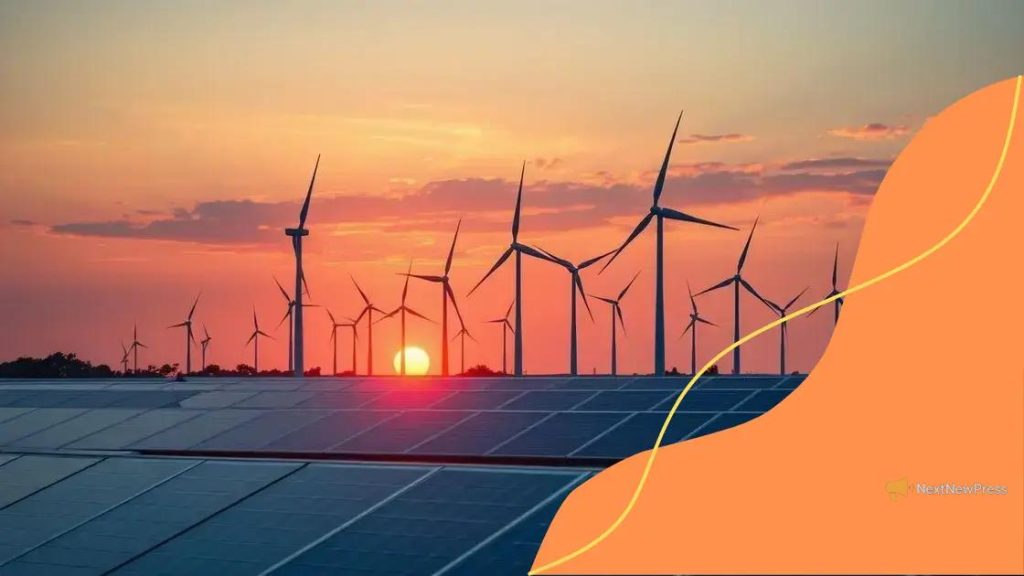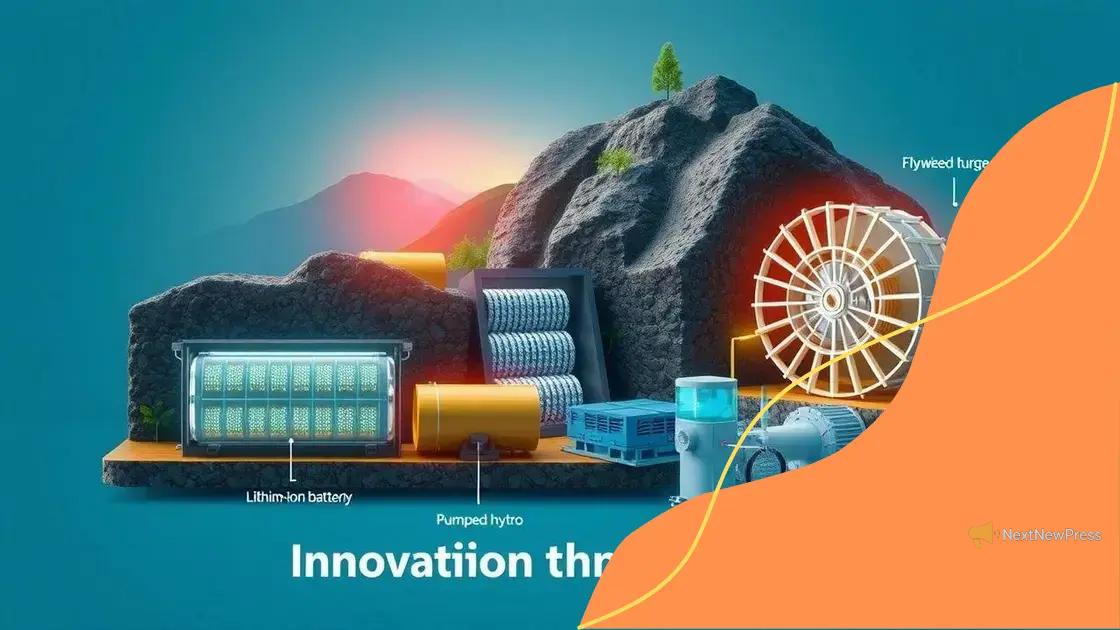Developments in sustainable energy technologies and infrastructure

Developments in sustainable energy technologies boost economic growth by creating jobs, enhancing energy independence, and fostering innovation, driving progress toward a cleaner future.
Developments in sustainable energy technologies and infrastructure are transforming how we harness power. Ever wondered how these advancements affect our daily lives? Let’s delve into the latest trends and their implications.
Recent breakthroughs in renewable energy
Recent breakthroughs in renewable energy are revolutionizing the way we think about powering our world. Each new innovation brings us closer to a sustainable future, and it’s exciting to witness these developments in real time.
One of the most impactful advancements has been in solar technology. Improvements in solar panel efficiency allow us to capture more energy from the sun than ever before. With the introduction of bifacial panels, which can collect sunlight from both sides, energy production has increased significantly.
Wind Energy Innovations
Wind energy has also benefited from technological advancements. New turbine designs are now more efficient and can generate power at lower wind speeds. This makes wind farms viable in more locations across the globe.
- Larger rotor blades for improved capture
- Advanced materials for higher durability
- Smart grid integration for optimized usage
In addition to solar and wind, energy storage solutions have seen remarkable progress. Batteries are crucial in balancing supply and demand for renewable energy.
Emerging Technologies in Energy Storage
Recent research in lithium-sulfur batteries and solid-state batteries promises to enhance energy density and longevity. These developments are paving the way for a more reliable renewable energy infrastructure.
Moreover, geothermal energy is gaining traction as a consistent energy source. Enhanced geothermal systems (EGS) are expanding possibilities for this stable power source, tapping into the Earth’s heat in areas previously deemed unviable.
Overall, these recent breakthroughs not only improve the efficiency of existing technologies but also play a vital role in reducing our reliance on fossil fuels. The integration of these advanced renewable energy solutions lays down the foundation for a cleaner and more sustainable energy landscape.
The role of government in sustainable energy
The role of government in sustainable energy is crucial for fostering innovation and encouraging the adoption of clean technologies. By implementing policies and regulations, governments can significantly influence how energy is produced and consumed.
One way governments can drive change is through incentives. Financial support, like tax credits and grants, motivates businesses and individuals to invest in renewable energy solutions.
Regulatory Framework
A strong regulatory framework is essential for ensuring that renewable energy projects are viable. Through environmental regulations, governments ensure that sustainable practices are followed. This creates a level playing field where renewable energy can compete effectively against traditional fossil fuels.
- Enforcing renewable portfolio standards
- Promoting net metering policies
- Encouraging energy efficiency standards
In addition, governments play a pivotal role in research and development funding. By investing in innovative technologies, they help pave the way for advancements in energy production and storage. This public investment is often crucial for private companies to take risks on new technologies.
Public Awareness and Education
Moreover, government initiatives also focus on public awareness. Campaigns promoting the benefits of sustainable energy can lead to increased community involvement and acceptance. When citizens understand the importance of transitioning to renewable energy, they are more likely to support necessary policies and initiatives.
In conclusion, the government is a vital player in creating a sustainable energy landscape. By providing the right mix of support, regulation, and education, they can encourage a shift toward cleaner energy that benefits all citizens.
Innovative technologies in energy storage

Innovative technologies in energy storage are essential for maximizing the efficiency of renewable energy systems. As the demand for clean energy rises, effective storage solutions become crucial in balancing supply and demand.
One key advancement in this field is the development of lithium-ion batteries. These batteries have transformed how we store energy for everyday use, making electric vehicles and renewable energy systems more viable. Their high energy density means they can hold more power in a smaller space.
Emerging Battery Technologies
Additionally, researchers are exploring next-generation battery technologies, such as solid-state batteries. Unlike traditional batteries, solid-state variants use a solid electrolyte, which enhances safety and performance. This innovation could lead to longer-lasting and more efficient energy storage systems.
- Increased energy density for lightweight applications
- Reduced risk of fire hazards
- Longer lifespan compared to conventional batteries
Another promising area is the use of pumped hydro storage. This technology has been around for decades but is seeing renewed interest due to its ability to store large quantities of energy effectively. By utilizing excess energy to pump water to a higher elevation, it can generate electricity when demand spikes.
Alternative Energy Storage Solutions
Beyond batteries and pumped hydro, innovative technologies such as flywheels and compressed air energy storage are gaining traction. Flywheels store energy in the form of kinetic energy and can quickly release it, providing grid stability. On the other hand, compressed air energy systems use surplus energy to compress air in underground caverns, which can be released to generate power when needed.
All these innovations play a vital role in enabling a sustainable energy future. By improving energy storage solutions, we can ensure that renewable energy sources are utilized efficiently, contributing to a cleaner environment.
Sustainable infrastructure design
Sustainable infrastructure design is essential for creating resilient communities while minimizing environmental impact. This approach focuses on integrating ecological principles into urban planning and development.
One key element is the use of green building materials. These materials not only conserve natural resources but also improve the energy efficiency of structures. For example, reclaimed wood and recycled metals are becoming popular choices in construction.
Designing for Energy Efficiency
Another important aspect of sustainable infrastructure is energy-efficient design. Incorporating natural light, high-performance insulation, and energy-efficient windows can significantly reduce energy consumption. These elements create comfortable indoor environments while lowering utility costs.
- Utilizing solar panels for renewable energy
- Implementing rainwater harvesting systems
- Creating green roofs to enhance insulation
Moreover, the concept of smart cities is gaining momentum. This involves using technology to optimize urban services and infrastructure. Smart sensors can manage traffic flow, water usage, and energy consumption, leading to more efficient resource management.
Community Engagement in Infrastructure Projects
Community involvement is vital in sustainable infrastructure design initiatives. Engaging residents in the planning process allows for a better understanding of local needs and priorities. This collaboration often leads to more effective and accepted solutions.
Additionally, incorporating green spaces into urban areas enhances biodiversity and promotes mental well-being. Parks, community gardens, and green corridors not only improve aesthetics but also provide vital habitats for wildlife.
Sustainable infrastructure design represents a holistic approach to development. By considering environmental, economic, and social factors, we can construct safer and more sustainable communities for future generations.
Impact of clean energy on economic growth
The impact of clean energy on economic growth is significant and multifaceted. As countries shift towards renewable energy sources, they create new job opportunities and stimulate local economies.
Investment in clean energy infrastructure often leads to the development of skilled labor. Training programs help workers transition from traditional energy jobs to roles in the renewable sector, fostering a workforce ready for the future.
Job Creation in Renewable Energy
Renewable energy industries, such as solar and wind power, generate thousands of jobs. These jobs include manufacturing, installation, and maintenance, contributing to both local and national economies. For example, communities with wind farms often see increased economic activity from local businesses.
- Installation and maintenance jobs for solar panels
- Manufacturing roles in turbine and battery production
- Research and development positions for innovative technologies
Furthermore, clean energy investments can lead to energy independence, reducing reliance on fossil fuel imports. This independence can stabilize national economies by insulating them from fluctuating oil prices.
The Role of Green Technologies
Emerging green technologies enhance productivity and create efficiencies in various sectors. From electric vehicles to smart grids, these developments drive down operational costs and encourage sustainable practices across industries. As businesses adopt these technologies, they often see improved profitability and enhanced brand reputation.
Overall, the transition to clean energy not only fosters job creation and innovation but also supports sustainable economic development. By putting a focus on renewable sources, governments can stimulate growth while addressing climate change challenges.
FAQ – Frequently Asked Questions about Clean Energy and Economic Growth
How does clean energy contribute to job creation?
Clean energy industries create a variety of jobs in manufacturing, installation, and maintenance, providing new employment opportunities.
What is the economic impact of investing in renewable energy?
Investing in renewable energy boosts local economies, reduces energy costs, and promotes sustainable growth.
How does energy independence affect a country’s economy?
Energy independence lowers reliance on imported fossil fuels, stabilizing the economy against price fluctuations.
What role do technological innovations play in the energy sector?
Technological innovations in clean energy lead to enhanced efficiency and productivity, driving economic growth across various sectors.





